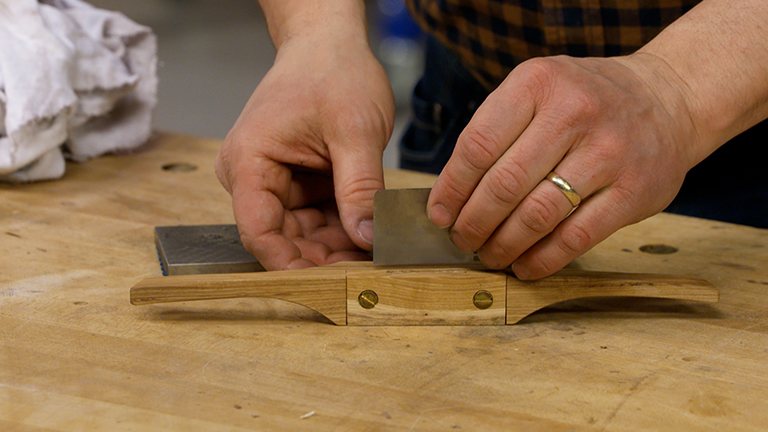 Looking for a fast, reliable, and affordable way to sharpen your edge tools? Man-made waterstones might be the answer.
Looking for a fast, reliable, and affordable way to sharpen your edge tools? Man-made waterstones might be the answer.
I’ve tried a lot of different sharpening methods over the years. And they each have advantages and disadvantages. But one of my favorite methods is waterstones. Waterstones are a great way to get a razor-sharp edge on your tools. They cut fast, making them very efficient as well.
HISTORY.
Japanese craftsmen, like carpenters, swordmakers, and woodworkers, have relied on natural waterstones for centuries to get a sharp edge. Some of the best natural stones have been mined in the mountains outside of Kyoto for more than 800 years. And master craftsmen in Japan still seek out natural stones, like those shown at left. But most of the best locations have been “mined out,” making the remaining high quality stones very expensive. Fortunately, the newer, man-made stones are readily available and are less expensive than natural stones.
MAN-MADE ADVANTAGES.
As much as natural waterstones are valued by traditionalists, man-made stones have the advantage of being more consistent in grit and structure. They’re made by mixing an abrasive compound with a bonding agent. This mixture is then formed into bricks that are fired at high temperatures to fuse everything together into a solid block.
When you shop for waterstones, you can assume they’re man-made unless labeled otherwise. The most common brands of man-made stones come from manufacturers like King, Norton, and Shapton.
 |
| Natural waterstones often show quarry marks on the edges and underside. |
FAST-CUTTING.
One reason waterstones have become popular is that they work faster than oilstones. That’s because the softer waterstone breaks down faster, exposing fresh abrasive with nearly every stroke. You get the same benefit with man-made stones.
This feature has the added benefit of preventing the stone from “loading up” with metal particles and glazing the more you use it.
USING WATERSTONES.
Most waterstones need to be soaked in water for 10-20 minutes before each use. I use a small, plastic container for soaking, like the one shown in the photo below. You can tell the stone is ready to use when it no longer releases air bubbles.
The Shapton stones are an exception. They only require a quick dousing before getting started. (Your stone should include instructions for preparing it for use.)
While sharpening, keep the surface wet by periodically adding water. This helps lubricate the tool edge and keeps metal particles from clogging the stone. I keep an old spray bottle near my bench for this purpose, but you could just sprinkle water on the stone with your fingers as you need it.
 |
| An inexpensive plastic container filled about halfway with water works great for soaking waterstones before each use. |
FLATTENING.
Another thing to keep in mind is that the face of the stone should be flat. As you use a waterstone, you can wear out a shallow “trough” in the soft stone. And that makes it difficult to keep a nice, straight edge on your tool. Now, you might wonder how you’d make a stone flat after it’s been used for a while. But you can purchase a “flattening stone” that’s specifically designed for the job.
PROGRESSIVE GRITS.
Another nice thing about waterstones is that you only need two or three grits for sharpening your tools. For most tasks, I can start with a 1000-grit stone and move directly to a 6000- or 8000-grit polishing stone. If you need to remove a lot of material, you can use a 150-grit or 220-grit stone. But these coarser grits are usually only needed when establishing a bevel angle or removing chips in the edge.
COMBINATION STONES.
Buying a set of single-grit stones can be expensive. An economical alternative is a combination stone — two stones of different grits glued together. The combination stone pictured above is a great way to get started without spending a lot.
 |
| This King combination stone offers both 1000-grit and 6000-grit for the price of a single stone. |
STORAGE.
No matter what kind of waterstones you use, when you’re finished using them, it’s a good idea to rinse them clean to remove any metal particles from the surface, then pat them dry. There’s no need to store them in water.
I’ve come to rely on waterstones because they produce a sharp edge in very little time. And that means I can spend less time sharpening and more time on my projects.
| Waterstone Accessories |
|---|
 |
If you’re ready to try your hand at sharpening with waterstones, there are a few accessories that can help make the job easier.
FLATTENING STONE.
The first item you might want to consider is a flattening stone. Since waterstones are so soft, you’ll find that they quickly dish out in the center. So you’ll need a way to true up the surface.
The fast-cutting abrasive stone shown at right is an inexpensive and effective solution. A few strokes in a figure-eight pattern will leave a flat face on your stones. But I don’t use a flattening stone on the higher grit stones I use for polishing. Instead, I just flatten a medium grit stone and in turn use it to flatten the polishing stones.
STONE HOLDER.
The stone holder pictured at right is also handy. It has rubber feet to grip the stone and prevent it from sliding around while you’re sharpening. It’s adjustable to fit just about any size stone and provides support in the middle to prevent the stone from cracking.
NAGURA.
A nagura stone isn’t used for sharpening on its own, but if you rub it on a polishing stone, it will quickly create an abrasive slurry that can speed the cutting action. It’s not required for most man-made stones, but you can still benefit if you use it on an 8000-grit or higher stone.











